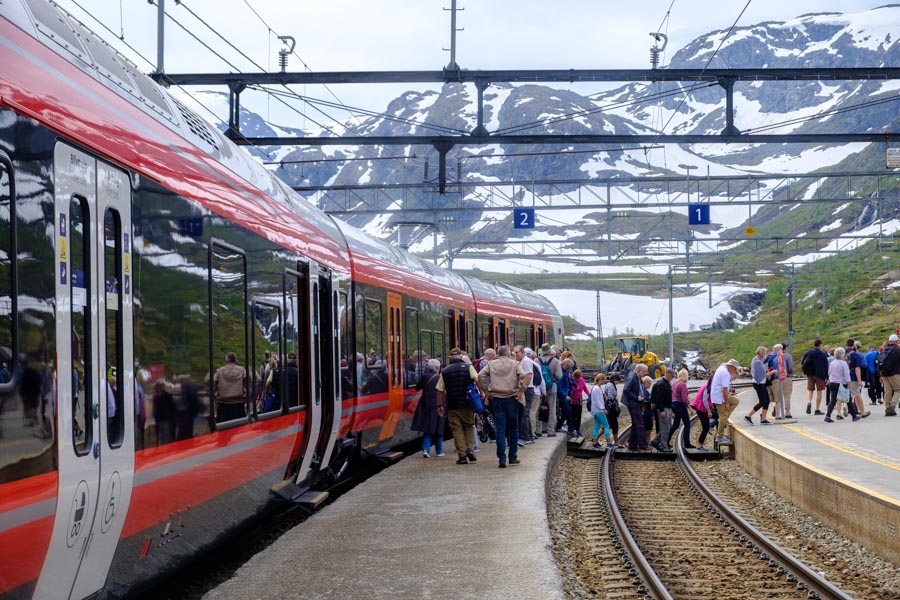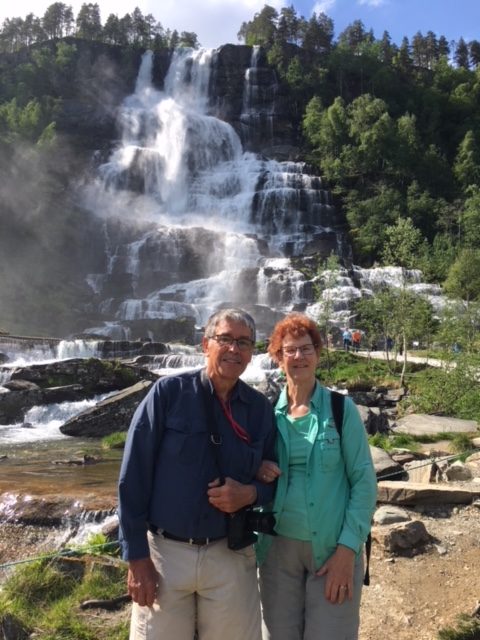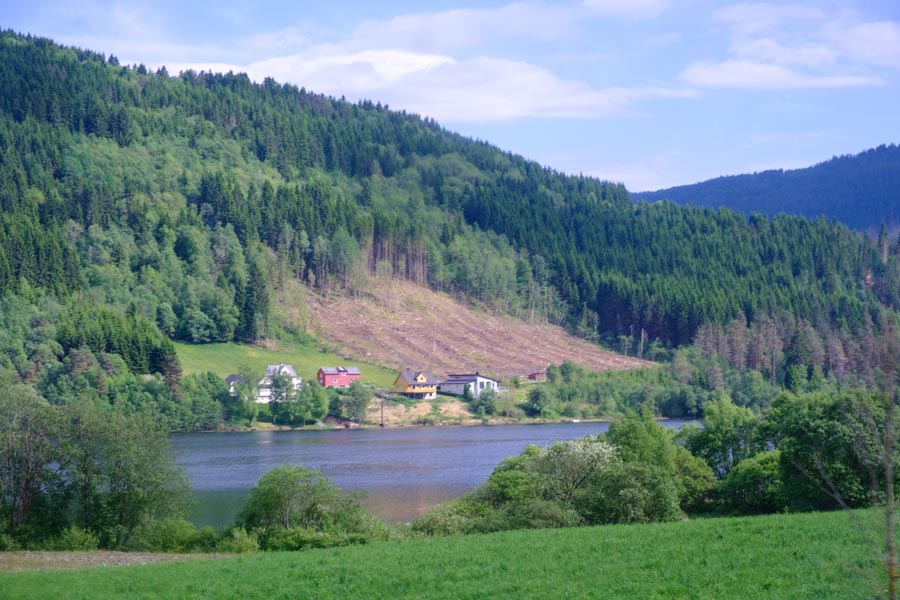No, not that kind of emergency-airlift-evacuation kind of fall, Rebecca and Jeff , we’re talking waterfalls here. And did we see waterfalls and spectacular Norwegian mountain scenery. We’ll post some pictures to show you what we mean.
The trip itself involved three bus segments and two train rides totaling about 7.5 hours, including a three-course buffet lunch, something we needed like a hole in the head: lots of sitting today and not much walking. In Southeast Asia I suffered from swelling of the ankles. This time it’s swelling of the belly.
The signature piece of today’s trip was the Flan Railroad, a 22 Km line built in the 1940s as a tourist attraction. It runs from Myrdal to Flan through spectacular mountain views and a mind-numbing number of tunnels. We got to Myrdal first by bus, stopping on the way for our first major waterfall, to the Vass train station. There we caught a regular train to Myrdal, a 45-minute ride in a most modern electric train. Only one hitch: a single toilet (#2 was out of service). So Judy and most of the rest of our crew spent the entire ride standing in line. I waited until 5 minutes before arrival and was the next-to-the last participant.
After the train ride we drove by bus to a resort hotel high in the mountains for the aforementioned luau. And then back to home base.
Speaking of tunnels, have you ever seen a guy who got a new tool and couldn’t stop finding uses for it? It’s that way with Norwegian road engineers and their tunnel-digging machine. Now granted, the eastern part of the country is built on a mountain range and tunnels do come in handy. But boy, do have they ever dug a bunch of tunnels. Long ones too: you can catch a 10-minute nap in most of them. One we went through today had two roundabouts underground.
And speaking of Norse mythology, check out the picture of the girl dressed in red, dancing by the falls. She’s some evil being who seeks to marry a baptized man at which point her tail falls off and she turns into an ugly wretch with whom the man is stuck forever. Don’t ask me; I report the myth, you judge.
Our guide (a guy from Netherlands today) said that it’s a reversal of the Old Norse folk stories about gnomes. Gnomes were said to live inside the mountains and would come out of night to bedevil human Norsemen. But gnomes, it turns out, are rather easy to fool so to avoid trouble humans had to trick the gnomes into doing stupid things. Then, at dawn, the gnomes would turn into stone. Today, Norse folk spend half their lives in the mountain tunnels; he didn’t say whether the Norse folk are simpletons like gnomes.
And speaking of mountains, our guide gave a simpleton’s explanation of fjords. About 20 million years ago the Iceland and Scandinavian plates collided pushing up the Scandinavian mountains that we traveled through today. Rain erosion wore away v-shaped valleys. About 12,000 years ago the last ice age deposited ice in the valleys. The weight of the ice dug out the v-shaped valleys to depths of up to 2,500 feet below current-day sea level. When the ice receded it left behind u-shaped fjords we know and love today.
The warm weather we’ve been experiencing on our trip so far has melted much of the snow at higher elevations (mountains around here top out at about 5,000 feet; the tree line is as low as 2,500 feet). The result: the better-than-normal waterfall flows we enjoyed today.
Our guide gave us a bit of Norwegian history too. Turns out, Norway was ruled by Denmark for 400 years or so. When Napoleon retreated from northern Europe Norway suddenly found itself free and independent. They wrote a constitution and signed it on May 17, 1804; May 17 is celebrated as Norwegian Independence Day. Norwegians of all walks of life dress up in Norse garments on that day.
“Not so fast,” said neighboring Sweden. The Swedish-Norwegian war started in July of 1804 and caused Norway to be ruled by Stockholm until 1905 when true independence was established. Then, neutral Norway was invaded by both Britain and Germany in 1940. Germany won a fierce battle and controlled the country until 1945.
Independence in 1804 kicked off a search for meaning: “What does it mean to be Norwegian? What is our culture? What do we stand for?” I’m sure the answer is complex but one interesting part of Norwegian life is the Freedom to Roam principle. It is legal for a Norwegian to occupy any non-commercial land for any purpose – a tent in someone else’s woods for example. Norwegians seem to have a strong connection with nature and the outdoors.
Schooling in Norway is completely free: Primary (6 years), Lower Secondary (3 years), Upper Secondary (3 years) and University (3 years). It’s free even for foreigners. High school seniors complete classes in April of their final Upper Secondary year. Then, for three weeks leading up to the May 17 independence holiday, the take off in their cars and travel the county or the nation, kicking up their heals and doing whatever well-behaved, I’m sure, Norwegian teenagers do for fun. They then come home and take their final examinations.
Enough of that. Tomorrow we’re in Stavanger, the home of Norwegian North Sea oil production, the industry that makes Norway the prosperous and progressive country is today. There’s a lot more money to be made selling crude oil than cod oil, that’s for sure.

















Thank you for all the Scandinavian history. Wow 50% of my salary would give me something to start a uprising!